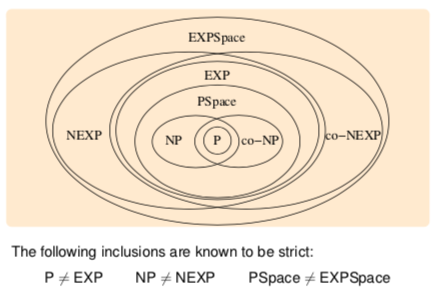Automata & Complexity
Table of Contents
Time complexity contd.
Bounded tiling problem
Input is natural number n, finite collection of types of tiles, the first row of n tiles is it possible to tile an n × n field with the given first row? when connecting tiles, the touching side must have the same color, tiles must not be rotated.

the problem is NP-complete
co-NP
Problem L is in co-NP if complement $\bar{L}$ is in NP. i.e. set of instances without solution is in NP.
we don’t know if NP = co-NP in general. but if an NP-complete problem is in co-NP, then NP = co-NP.
EXP and NEXP
Nondeterministic TM is exponential time if it runs in time $2^{p(|x|)}$ for some polynomial p.
NEXP is nondeterministic exponential, EXP is deterministic exponential.
P ⊆ NP ⊆ PSpace ⊆ EXP ⊆ NEXP. we don’t know if this is strict. we know that P ≠ EXP, NP ≠ NEXP.
Space complexity
Nondeterministic Turing machine M runs in space f if for every input w, every computation of the machine visits at most f(|w|) positions on the tape. i.e. the function f is the upper bound on number of visited cells on tape (length of input word)
PSpace and NPSpace
Nondeterministic Turing machine is in polynomial space if it runs in space p for some polynomial p.
NPSpace is if it runs in nondeterministic polynomial space, PSpace if deterministic.
Savitch’s theorem: if language accepted by nondeterministic TM in f(n) space, then accepted by deterministic TM in f(n)² space. PSpace = NPSpace.
A language L ∈ PSpace is PSPace-complete if every language L’ ∈ PSpace is polynomial-time reducible to L.
Complexity hierarchy
